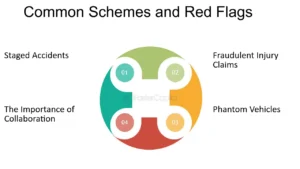INTRODUCTION
Insurance fraud is a deceptive practice aimed at exploiting insurance policies for financial gain through false claims, staged accidents, or other fraudulent activities. It undermines the integrity of insurance systems, drives up premiums for policyholders, and imposes significant costs on insurers and society as a whole. In this comprehensive analysis, we’ll explore the intricacies of insurance fraud, focusing on false claims and staged accidents, their characteristics, impacts, detection methods, and prevention strategies.

1. False Claims: False insurance claims involve individuals or groups submitting fabricated or exaggerated claims for losses or damages covered by insurance policies. These claims may involve property damage, vehicle accidents, medical treatments, or other covered events, with the aim of receiving undeserved compensation from insurers.
2. Characteristics of False Claims:
- False claims may be made for various types of insurance policies, including auto insurance, property insurance, health insurance, disability insurance, and life insurance.
- Perpetrators of false claims may include policyholders, beneficiaries, professionals (such as medical providers or repair contractors), and organized criminal networks.
- False claims often involve the falsification of documents, receipts, invoices, medical records, or witness statements to support fraudulent claims.
3. Impacts of False Claims:
- False insurance claims impose significant financial losses on insurers, leading to higher premiums, reduced profitability, and increased operational costs for the insurance industry.
- Honest policyholders bear the burden of increased premiums and reduced coverage due to the financial losses incurred by insurers as a result of fraudulent claims.
- False claims erode public trust in insurance systems, undermine the effectiveness of risk management, and contribute to the proliferation of fraudulent activities across various sectors.
4. Staged Accidents: Staged accidents involve the deliberate orchestration of vehicle collisions, injuries, or property damage to create fraudulent insurance claims. Perpetrators may stage accidents for the purpose of filing false injury claims, property damage claims, or healthcare fraud schemes.

5. Characteristics of Staged Accidents:
- Staged accidents may be conducted by individuals acting alone or in collusion with others, including co-conspirators, accomplices, or professional fraud rings.
- Common types of staged accidents include rear-end collisions, sideswipe collisions, staged thefts, pedestrian accidents, and fraudulent hit-and-run incidents.
- Perpetrators may employ various tactics to stage accidents, such as sudden braking, lane changes, illegal maneuvers, or intentional collisions with stationary objects.
6. Impacts of Staged Accidents:
- Staged accidents contribute to rising insurance premiums, increased claim payouts, and higher costs for insurers, as fraudulent claims are processed and compensated.
- Legitimate accident victims may face challenges in receiving prompt and fair compensation for their losses, as insurers become more cautious and skeptical of suspicious claims.
- Staged accidents pose risks to public safety, as perpetrators engage in reckless driving behaviors and put innocent motorists, pedestrians, and bystanders at risk of injury or harm.

7. Detection and Prevention Strategies:
- Detecting insurance fraud requires advanced analytics, data mining techniques, and predictive modeling to identify patterns, anomalies, and red flags indicative of fraudulent activities.
- Collaboration between insurers, law enforcement agencies, regulatory bodies, and industry associations is essential for sharing information, coordinating investigations, and prosecuting perpetrators.
- Implementing fraud prevention measures, such as stricter underwriting standards, claims monitoring systems, fraud detection software, and anti-fraud training programs, can help deter fraudulent activities and protect insurers from financial losses.
8. Legal Implications:
- Insurance fraud is a criminal offense punishable by law in many jurisdictions, with penalties including fines, imprisonment, restitution, and forfeiture of assets for convicted offenders.
- Insurance regulators and law enforcement agencies conduct investigations, audits, and prosecutions to combat insurance fraud, hold perpetrators accountable, and deter future fraudulent activities.
- Strengthening legal frameworks, enhancing enforcement mechanisms, and imposing harsher penalties for insurance fraud can serve as deterrents and disincentives for individuals considering engaging in fraudulent activities.
In conclusion, insurance fraud, including false claims and staged accidents, poses significant challenges for insurers, policyholders, and society as a whole. Detecting and preventing insurance fraud require concerted efforts from stakeholders across the insurance industry, law enforcement, regulatory agencies, and the legal system. By implementing robust fraud detection measures, fostering collaboration, and enforcing strict penalties for fraudulent activities, stakeholders can safeguard the integrity of insurance systems and protect consumers from the financial and social costs of insurance fraud.


